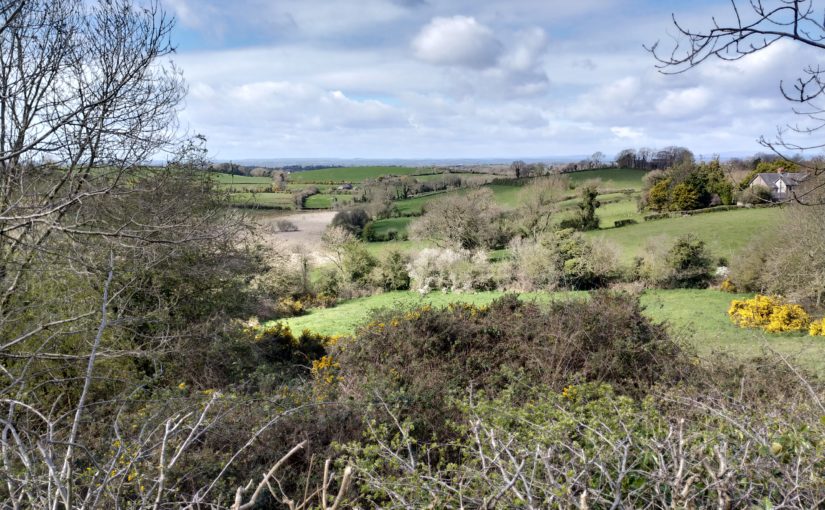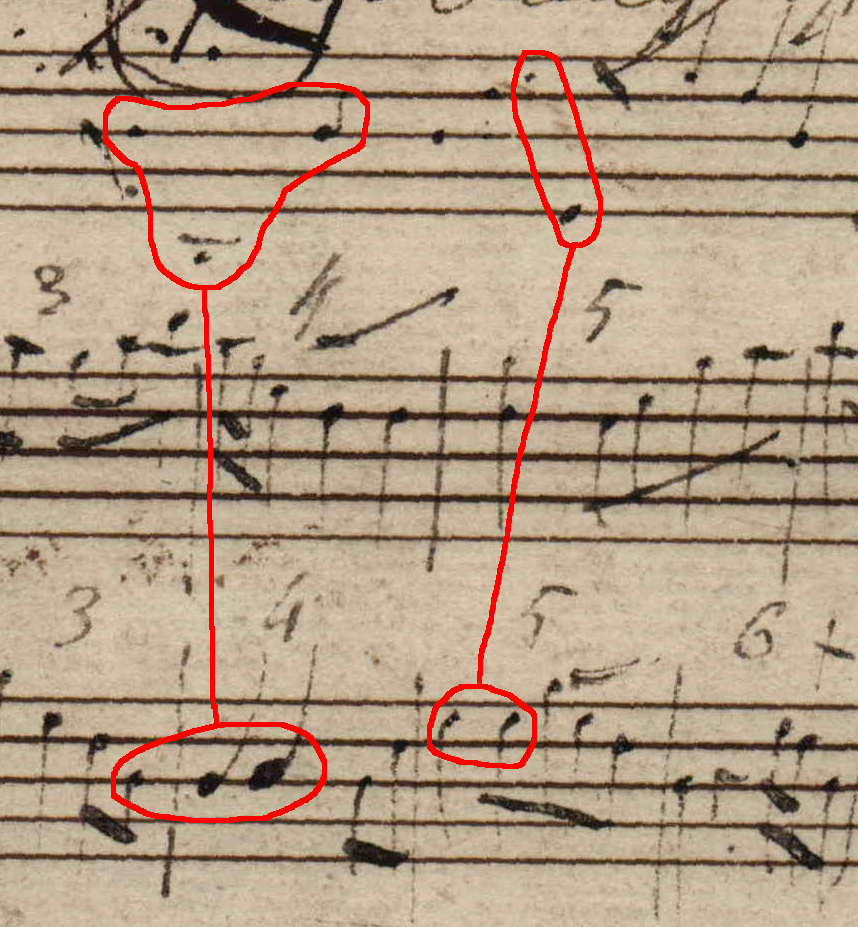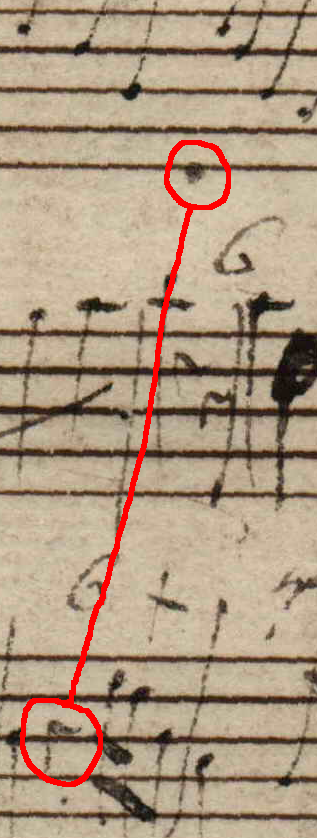Edward Bunting made a transcription of the tune of Ríoghán an uaigneas into one of his collecting pamphlets, now at Queen’s University Belfast, Special Collections, MS4.29 page 233/231/240/f115r.
This is a very interesting notation that looks like it was written live from the performance of an old Irish harper.
Page 233 contains two notations. The first two staves are Bunting’s dots transcription, which look like they were written down live while the harper was playing. Then, underneath, the last two staves are Bunting’s neat edited copy. I believe that this shows clearly his working method – he sat beside a tradition-bearer, and dotted down the tune as they played; and then he re-wrote it neatly as the first step in de-traditionalising it on the way to creating the published classical piano arrangement.
Here is the manuscript page, and a machine audio of both of the notations so you can follow them and compare them. You can also download my PDF typeset version of each: the dots and the edited copy.

The title is written “Lady of the Desert” above the dots, and then “Riguin an uaigneas Lady of the Desart” in the middle of the dots. At the bottom of the page is the text “1st part of the Every part twice / 2 verse played an octave lower”. I think we should understand this as “1st part of the / 2[nd] verse played an octave lower” and “Every part twice”, i.e. that the double bar lines should be interpreted as repeat marks, and that the “first part of the second verse” is written an octave higher than it should be.
“1st part of the / 2 verse played an octave lower”
This raises important questions. Does Bunting mean that the harper informant played it low, and he wrote it up, presumably to avoid millions of ledger-lines? Or does he mean that he would like to shift it lower for his forthcoming piano arrangement, contrary to how it was performed on the harp?
Also what does Bunting mean by “1st part of the 2 verse”? Does he think of the entire tune being one verse, with the entire tune being repeated for each verse? Or does he think of each half of the tune being a verse? I presume the former, because of his mentioning “Every part twice” which makes most sense of we understand the tune as written to contain two parts.
So one possible interpretation is to think that the entire tune is played as written, and then the entire tune is repeated, but the first 8 bars up to the double bar line in the neat copy, are shifted an octave down on that repetition.
Bass notes
We are normally quite interested to see Bunting writing notes at different octave registers, especially if they are labelled with the letter “B” for bass. There is an old trope that Bunting neglected to transcribe the harpers’ basses or accompaniments; I think this is not really true. I think that firstly the harpers didn’t have “accompaniments”, there are plenty of hints that they expressed the melody with both hands, taking the important or strong notes in the bass with the right hand. And secondly, Bunting did mark in a fair few “B” notes; and it seems clear that he didn’t note down every single note played by the right hand. Indeed, I imagine it would have been difficult for him to watch the hands of the harper whilst also writing the notation; and I also think he was not that bothered with the niceties of performance practice, being much more concerned to collect the melodies of the tunes which he intended to publish as piano arrangements.
What is very unusual here is that the dots transcription seems to show notes that look like octave jumps down into the right hand, where the neat transcription either ignores these notes or folds them up into the tune register. There are two obvious examples, both in the second half. In bar 11-12 (Bunting’s 2nd half bar 3-4) the dots have high B – low B – high B where the neat copy has three repeated high Bs. And in bar 13 (Bunting’s second half bar 5) the dots have high E – low E where the neat copy has two repeated high Es.
In bar 9 (Bunting’s bar 1 of the second half) Bunting inserts an octave jump down and back up (high F – low F – high F with a + mark over it) but if we look up at the dots we see no low F, just a high F and then a crushed group F-G-F. As well as wondering if Bunting invented the low F, we also can see how he has used the + mark in his neat copy as a kind of shorthand for the little trill or turn ornament that is written in full as F-G-F in the transcription dots.
There is also what looks like a low E in bar 14 of the dots, which becomes a rest in the neat copy. Is that an abandoned F dot in the neat copy? Are these all just ink spots? Sometimes it is hard to tell:
What can this kind of anomaly tell us about what Bunting was hearing when he made these transcriptions?
There is also the question about the dyad D-G which appears in the first section. The dyad appears in bar 4 in both dots and neat copy; but the very beginning of the tune has just G in the dots, which becomes the D-G dyad in the neat copy. Has Bunting invented this? Is this a bass note folded up onto the treble clef stave, or what?
In any case there is plenty here that could be used to inform an idiomatic harp reconstruction.
Other versions of this tune
Bunting published a piano arrangement as no. 34 in his 1797 collection. You can hear Bunting’s classical piano arrangement on Fiachra Ó Corragáin’s website. In the piano arrangement, Bunting has written the second half of the tune out twice, but the first part only once. Donal O’Sullivan (Bunting part II, 1930, p.1) says “Nothing appears to be known of the tune… No variant of it has been printed and no words for it have been recovered”
Title
The manuscript seems to give “Lady of the Desert” and “Riguin an uaigneas Lady of the Desart”. Bunting’s 1797 printed book gives “Riguin an uaigneas The Forlorn Queen”. Ríoghán is a word for a queen (perhaps with archaic or mythical overtones); Uaigneas is loneliness, and so our title seems to mean the queen of loneliness. The English version “Lady of the Desert” or “Desart” is interesting, reminding us of the completely different tune of that title. I think the Desart is an old Scots word referring to a hermitage or retreat (there is a place-name Dysart in Fife with this derivation).
Dating and attribution to a harper informant
The tune is not in the May 1796 proof sheets, which may suggest that this transcription was made in the summer of 1796, but it is equally possible that it was done in the summer of 1792. (see my post on Bunting’s collecting trips).
In his personal copy of the 1797 print, Edward Bunting wrote attributions perhaps in the early 1840s. On this tune he writes “Harp Oneil” and he also writes “wants 7th / but has 7♮ / Set this / in C♮”. At the bottom of the page under tune no.35 he writes “both airs very ancient”.
I take all this to mean that around 50 years after making this transcription notation, he believed that he had got it from the harper Arthur O’Neill. Whether we believe this or not is hard to decide.
Many thanks to Queen’s University Belfast Special Collections for the digitised pages from MS4 (the Bunting Collection), and for letting me use them here.
Many thanks to the Arts Council of Northern Ireland for helping to provide the equipment used for these posts, and also for supporting the writing of these blog posts.





♀️♀️♀️
Thank you as always for the wonderful research you do!
Ps. I have the words which i am fitting to the music and finding I have to repeat the last part of Stanzas for the music to fit!